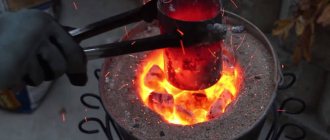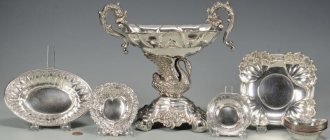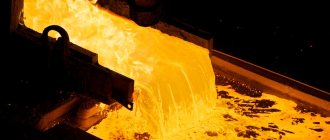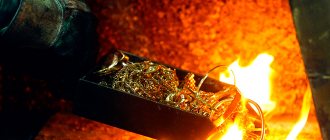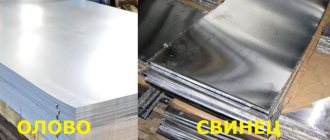Post updated: Jun 6, 2020
Gold is used for different purposes, as well as in different areas: in industry, medicine, investment. But jewelry production has always been considered the most important consumer of the yellow metal. In Russia, the 585 standard metal is most widely used. For jewelry makers, the physical characteristics of the alloy are of great importance: color, density and melting point of gold.
585 sample in this regard is the best option in terms of price-quality ratio.
Why is gold melted and mixed with less precious metals?
Gold is a hard, refractory metal that is often mixed with other metals such as copper, silver, iron, aluminum, and platinum. At the same time, it often changes color (it becomes white, brown, red). Purposes of alloys:
- Increased strength. Pure gold is easily deformed. Therefore, it is fused with stronger elements - this way you can get a harder material.
- Saving money. Pure gold is an extremely expensive metal. To save money, it can be fused with cheaper components - the price of the final product will be lower.
- Giving gold a unique color (pink, white, green, blue, purple and other alloys). Ligatures of various metals are responsible for the corresponding shade.
To mix metals, they need to be heated to a certain temperature at which it turns from solid to liquid (melting phenomenon). This indicator is called the melting point. If necessary, the material can be heated even after it has melted.
Once a certain temperature is reached, gold may begin to evaporate (this point is called the boiling point).
Gold bullion production process
What is gold
In its pure form, gold is a shiny metal with a bright yellow color.
Number 79 of the periodic table, international designation – Aurum (Au). One of the most “massive” but soft metals with a cubic lattice structure centered on the faces. The name in modern languages goes back to a Proto-Indo-European root meaning “yellow, green, bright.” The Latin name, given in honor of the goddess of the dawn, Aurora, is also translated as “yellow”.
Maximum melting temperature of gold: the higher the purity, the higher the degree
Fineness is the specific concentration of gold in the alloy. The most popular hallmarks are 999, 585 and 375. The number reflects the ratio of gold content per 1000 units of material. 1 kg of 999 fine contains 999 grams of gold, and the remaining 1 gram is impurities. The rule applies: the higher the sample, the higher the melting point.
- 375 gold melts and becomes liquid at a temperature of approximately 600-750 degrees.
- 585 gold product - at a temperature of about 700-850 degrees Celsius.
- The melting point of 999 gold is 1064 degrees Celsius. The boiling point of high-grade gold (999) is about 2700 degrees.
Important! If you are interested in the melting point in Kelvin, then add 273 to the numbers.
The melting point of gold depends on its purity
Hallmark on 585 hallmark
The authenticity of the yellow metal must always be confirmed by a stamp indicating its purity. In Russia, this procedure is mandatory and controlled by the state. The hallmark allows the buyer to be confident in the quality and authenticity of the precious metal.
There are three branding options:
- Laser;
- Electroerosive;
- Mechanical.
The modern laser method allows you to place a mark with a high degree of readability. But the image can quickly be erased, especially if the branding site is constantly in contact with another surface. The mechanical method is still recognized as the most durable.
An example of a mark on a product and its explanation.
The mark itself consists of three parts: a letter (the hallmark code), a drawing (a woman’s head with a kokoshnik, looking to the left), and the number “585” (the hallmark itself). In addition to these symbols, a piece of jewelry may have another mark – the manufacturer’s name.
Products that are imported into Russia are also tested. In Italy and the USA there is no state standard and all responsibility for the authenticity of jewelry lies only with the manufacturer. The mark on foreign products usually consists of the symbols “14 K” (14 carats, corresponding to the domestic 585 standard) and letters indicating the manufacturer.
Comparative analysis of melting temperatures of gold of various samples
| Gold | Silver | Copper | Zinc | Cadmium | Melting temperature |
| 999 | Trace amount | Trace amount | Trace amount | Trace amount | 1064 |
| 585 | 138 | 229 | 36 | 12 | 850 |
| 585 | 163 | 207 | 46 | 850 | |
| 585 | 125 | 205 | 85 | 830 | |
| 585 | 160 | 205 | 30 | 20 | 820 |
| 585 | 150 | 205 | 30 | 30 | 800 |
| 585 | 193 | 133 | 33 | 56 | 790 |
| 585 | 100 | 225 | 90 | 770 | |
| 585 | 104 | 176 | 20 | 115 | 710 |
Finding in nature and human use
In its original form, gold is found in nature in the form of ingots, sand or inclusions in rocks. Placers of gold are places where they are mined by humans. Mixed with sand, clay and other parts, it is extracted and then separated in its pure form.
Gold is also contained in:
- plants;
- animals;
- human body;
- groundwater;
- seas and oceans;
- lithosphere.
From all these places people learned to extract metal to use for their needs. What is it for?
- The most important industry is, of course, jewelry. Beautiful jewelry made from different gold alloys are the main sign of financial wealth for almost every woman. They are given to loved ones, money is invested in them, they are admired and appreciated.
- Technique. The melting point of gold and platinum, as well as palladium, nickel and some other metals, makes them very valuable for technical use. And the property of gold to have a high degree of malleability and ductility, combined with chemical inertness, allows the use of wire from this metal in the smallest parts, chips. For example, phones, TVs, calculators and other electronic devices.
- Gold is a hard currency around the world that never depreciates. It is not afraid of inflation and default, so many people keep their savings in ingots of this metal.
- Awards for achievements in various sports, tournaments and games are made of gold, silver and bronze, which once again emphasizes their high value.
Stages of preparing gold for factory smelting
To produce gold bars, natural ore or nuggets are used, which undergo a procedure of mining, beneficiation and smelting. Most often, ore is smelted at factories using special furnaces after three-stage preparation:
- Mechanical cleaning of material. Strong water pressure is used to separate particles from soil and stones. Water may contain additional additives that improve the quality of cleaning.
- Refining-chemical cleaning (from impurities). Cleaned metal still contains particles of dust or other elements. To reduce their number, the material is washed with aqua regia.
- Deposition of a metal alloy. After cleaning with aqua regia, the material is placed in clean water, where the final purification of the material occurs. The particles sink to the bottom (due to their high density) - after settling, they are taken out and dried.
Melting gold in special melting furnaces
The gold particles are placed in a furnace where they are heated to the melting point. After reaching it, they take a liquid form and merge into the corresponding forms of an ingot or product (depending on the shape of the crucible) until they cool completely. Various furnaces can be used to melt material in factories:
- Gas. The crucible is placed inside the furnace, and a gas burner is supplied. During startup, the burner heats the crucible, which transfers heat to the gold particles.
- Induction. The crucible is supplied with electrical wires connected to a current source. When the circuit is completed, the electricity heats the mold and melts the material inside.
- Muffle. Electric heating elements are connected to the crucible from below and on the sides. They begin to heat up when the circuit is closed, which also leads to the melting of the material.
Gold smelting - technology
TOP 3 effective ways to melt gold at home
The main methods of melting gold products in factories were discussed above. However, there are craftsmen who have learned to transform this material at home. Practice shows that such smelting is “blacker” than factory smelting. If you follow the basic rules of remelting, you can obtain a completely pure alloy that will contain a minimum of impurities. Instructions on how to melt gold yourself:
How gold raw materials are processed
Before turning into an ingot, coin or jewelry, the precious metal undergoes multi-stage processing. The charge - the material to be sent to the smelting furnace - can consist of both grains of gold mined in nature and scrap (watch, jewelry, technical, dental). Preliminary manipulations are aimed at making this mixture as homogeneous as possible before melting. To do this, processing plants subject raw materials to the following procedures:
- Mechanical cleaning: crushing large pieces, grinding and sifting under running water or a solution with the addition of an abrasive, which additionally washes the mixture from dirt.
- Chemical purification from impurities - refining. Variations: amalgamation, dissolution in aqua regia or leaching - cyanidation or using theourea solutions.
- Precipitation of metal from the resulting solutions.
As a result of purification, gold is at the disposal of a factory worker (or a private jeweler) - in an amount much smaller than the original charge, but practically pure.
You can start melting.
What metals are used in gold alloys, how do they change the melting point
The need to change the melting temperature of the alloy especially often arises in the manufacture of solders. More low-melting additives lower the melting point of gold:
- zinc;
- tin;
- magnesium;
- aluminum;
- silver (negligible).
More refractory metals and their alloys increase the melting point - in jewelry and industry this is mainly the platinum group:
- platinum;
- palladium;
- osmium.
Most intermetallic alloys are brittle, so they are almost never used to create jewelry, and their suitability for industrial use is limited.
Equipment and materials for home metal smelting
The list of necessary equipment depends on the method of metal remelting:
- Melt using a burner. To carry out the work you will need a gas cylinder and a burner (autogen). It is recommended to melt gold on a refractory brick, which will not begin to crumble when heated. The crucible can be made from refractory clay. It is also recommended to use refractory tongs to place the material into the crucible.
- Melt using a melting furnace. Most melting furnaces sold in online stores are in the jewelry category. They are completely autonomous (the design contains its own crucible). Therefore, you will only need gold particles.
- Melt using a microwave. For melting, use a microwave oven with a power of 1200 watts or more. You will also need two bricks - two recesses should be made in them (the bricks are placed in the oven with the recesses facing each other to create free space). It is recommended to make the crucible from graphite (microwave radiation can melt the clay).
Gold: general characteristics
Aurum, or gold, is chemical element number 79 on the periodic table. The atomic mass is 196.967 units. Located in group I, a secondary subgroup. Refers to noble metals, along with:
- platinum;
- silver;
- palladium
From the point of view of chemical activity, it is practically inert and does not react without special conditions. It has special physical properties that allow it to be used in jewelry, technology, and industry.
Section question - answer
Melting point of 585 gold in degrees Celsius?
Expert opinion
Pribrezhny Gennady Valentinovich
Jeweler 6th category
It all depends on what alloying additives and in what quantities are included in the alloy in addition to gold. Typically, the melt temperature of 585 sample is in the range from 700 to 850 degrees.
Melting temperature of gold at home
Expert opinion
Grishanov Mikhail Petrovich
Jeweler, director of the Grishanov and Co. workshop
Everything depends primarily on the sample + you need to make a small addition on top, since higher heat losses are usually observed outside. 585 sample is recommended to be heated to 900 degrees, 999 to 1200 degrees, 375 to 800 degrees.
Does gold melt in a fire?
Expert opinion
Pribrezhny Gennady Valentinovich
Jeweler 6th category
It all depends on how exactly the building burns and what type of product is inside it. Typically, in a serious fire, the fire can heat the room to 900-1100 degrees. Samples 585 and 375 melt at this temperature, but, if you're lucky, the product 999 samples will remain unharmed.
Melting gold at home
Does gold melt in a fire?
Expert opinion
Grishanov Mikhail Petrovich
Jeweler, director of the Grishanov and Co. workshop
This is possible, although in practice it is rarely used due to high heat loss, as well as the risk of contamination of the product. A good fire is on coal. If heated with wood from the forest, melting will not occur.
At what temperature does gold melt at home, how to melt it?
Expert opinion
Pribrezhny Gennady Valentinovich
Jeweler 6th category
Heating should be carried out with a small margin. The optimal temperature for casting 585 is 900 degrees, 375 is 800 degrees, 999 is 1200 degrees. Use a stove or gas burner to heat. You can also melt using a microwave.
Metal density
The density characteristic itself means the weight of a substance per unit volume. So gold has almost the maximum indicator for this parameter. So, for example, half a glass of pure golden sand will weigh about 1000 grams.
The density of gold, purified from impurities, is 19.3 g/cm3. If we talk about natural gold-bearing rocks, then the indicator is slightly lower - 18-18.2 g/cm3. This indicator allows you to conveniently extract the metal in question from rocks. He makes gold so expensive for a very small amount per gram.
How to make a homemade melting torch
It is not difficult to purchase a gas or gasoline device. A jewelry gasoline unit is safe and costs between 1000-2000 rubles. However, if you have the time and desire, you can make a melting torch yourself. It’s easier to make gasoline at home.
We will need:
- Any compressor - from a refrigerator, an aquarium, a nebulizer or a foot compressor - to supply air.
- Plastic container - for example, a milk bottle.
- Hoses.
- Sealant.
- And, the most difficult thing, nozzles for supplying a directed flame. It is better to make several of them to order in order to get a powerful stream of flame for melting or a flame-needle for repairing jewelry or solder. But you can also use an air injector, make several injectors from gas jets - you can buy them in the gas industry and drill larger holes, from 1 to 3 mm.
Assembly steps:
- We weigh down a plastic container for gasoline by gluing it to a ceramic tile or sheet of metal. This must be done for fire safety purposes, so as not to overturn the bottle of gasoline during operation.
- We make two holes in the container - one in the lid of the bottle to supply air from the compressor to the bottle, the second to supply gasoline-air vapors to the burner.
- We connect the hoses: the first - from the compressor to the bottle (it should reach the bottom), the second - from the container with gasoline to the burner itself.
- We seal the joints.
- The simplest version of the burner is a steel tube with a gas jet screwed into it. But for the sake of simplicity and safety, I recommend purchasing a ready-made one - its cost will not exceed 200 rubles.
The assembly process of the entire structure is described in the video:
Precious metals - into coins
The power of gold over a person was fully demonstrated when, from a luxury item, the “despicable metal” became a measure of the value of a product—money. The Lydians were the first to think of making coins from gold.
The last Lydian king Croesus (remember, of course - “rich as Croesus”) came up with a bimetallic (gold-silver) system. The idea was so successful that it lived and flourished for many centuries.
We recommend: MANGANESE - the dream of steelworkers
Darius, the Persian king, began to mint his own image on coins instead of a stamp.
The monetary standard between gold and silver was often 1:10. But the ratios were constantly changing. In Ancient Egypt, silver was more expensive than gold.
How much gold is in a ring
States strictly control purity measures, that is, the content of precious metals, in alloys.
A sampling system has been developed for this purpose. This is the determination of the amount of pure metal in an alloy. This quantity (sample) is called a stamp.
Important: in Russia, alloys containing more than 30% precious metal must be hallmarked.
There are 4 sample systems. The most popular are carat and metric.
The metric system is adopted in countries that have signed the Convention on the Hallmarking of Precious Metals. These are Russia, France, Germany, Israel, Cyprus and several other countries.
The British karate system is preferred in Canada, Switzerland, and the USA. The Irish wisely put both standards on the product - carat and metric. And the UK sets the metric standard, but also indicates the carat standard in the product description.
Informative: if you want to convert carats into a metric standard, multiply the number of carats by 125 and divide by 3. That is, an 18-karat product will correspond to a 750 standard (18x125:3).
Let's recalculate the metric hallmark into carats - multiply the metric hallmark by 24 and divide by 1000. That is, a product with a hallmark of 750 will correspond to 18 carats.
